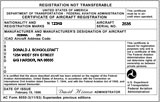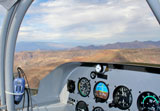|
Experimental LSA Operating LimitationsExperimental LSA Operating limitations must be designed to fit the specific situation encountered. As mentioned before, the FAA/DAR may impose any additional limitations they deem necessary in the interest of safety. The following experimental LSA operating limitations will be prescribed for the operation of experimental light-sport aircraft when certification has been conducted under the provisions FAR 21.191(i)(1), (2), or (3), and will be listed as shown below: 1. No person may operate this aircraft for other than the purpose of meeting the requirements of FAR 91.319(b) during phase I flight testing and, for the purpose of operating light-sport aircraft, after meeting these requirements as stated in the program letter (required by FAR 21.193) for this aircraft. In addition, this aircraft must be operated in accordance with applicable air traffic and general operating rules of part 91 and all additional limitations herein prescribed under the provisions of FAR 91.319(e). These operating limitations are a part of Form 8130-7, must be carried in the aircraft at all times, and must be available to the pilot in command of the aircraft. 2. This aircraft must display the word “experimental” in accordance with FAR 45.23(b). 3. This aircraft does not meet the requirements of the ICAO applicable comprehensive and detailed airworthiness code as provided by Annex 8 to the Convention on International Civil Aviation. The owner/operator of this aircraft must obtain written permission from another Civil Aviation Authority (CAA) before operating this aircraft in or over that country. That written permission must be carried aboard the aircraft together with the U.S. airworthiness certificate and, upon request, be made available to an Aviation Safety Inspector (ASI) or the CAA in the country of operation. 4. Application must be made to the geographically responsible FSDO or MIDO for any amendment to these operating limitations. 5. During phase I flight testing to meet the requirements of FAR 91.319(b), or as a result of the incorporation of a major change, all flights must be conducted within the assigned geographic area. a) The area must be described by radius, coordinates, and/or landmarks. b) The designated area must be over open water or sparsely populated areas having light air traffic. c) The size of the area must be adequate to safely conduct the anticipated maneuvers and tests. 6. Flight testing required for phase I operations or as a result of the incorporation of a major change will be conducted in the assigned test area. Flight test operations will only be conducted under VFR day conditions, with the pilot as the sole occupant of the aircraft. This aircraft must be operated for at least 5 hours in the assigned geographic area. Following the satisfactory completion of the required number of flight hours in the flight test area, the pilot must certify in the aircraft records that the aircraft has been shown to comply with FAR 91.319(b) with a statement that includes the followinginformation: “I certify that the prescribed flight test hours have been completed and the aircraft is controllable throughout its normal range of speeds and throughout all maneuvers to be executed, has no hazardous operating characteristics or design features, and is safe for operation. The flight test was completed under the following conditions: maximum operating weight, style/set of wing or sail, maximum demonstrated airspeed, and minimum demonstrated stall speed.” All major changes or modifications will be listed in the aircraft records and the compliance statement will be restated with the changes listed. The aircraft may not be operated in excess of the weights and speeds demonstrated. 7. Any change to the flight test area location or size must be coordinated with the geographically responsible FSDO where the aircraft is based, with FAA concurrence received in writing. 8. Except for takeoffs and landings, this aircraft may not be operated over densely populated areas or in congested airways. 9. This aircraft is prohibited from operating in congested airways or over densely populated areas, unless directed by air traffic control, or unless sufficient altitude is maintained to effect a safe emergency landing in the event of a power unit failure, without hazard to persons or property on the ground. NOTE: This limitation is applicable to the aircraft after it has satisfactorily completed all requirements for phase I flight testing, has the appropriate endorsement in the aircraft logbook, and is operating in phase II. 10. This aircraft is to be operated under VFR day only. 11. After completion of phase I flight testing, unless appropriately equipped for night and/or instrument flight in accordance with FAR 91.205, this aircraft is to be operated under VFR day only. 12. No person may operate this aircraft for carrying persons or property for compensation or hire. 13. The pilot in command of this aircraft must advise the passenger of the experimental nature of this aircraft and that it does not meet the certification requirements of a standard certificated aircraft. 14. This aircraft must contain the placards and markings as required by FAR 91.9. In addition, the placards and markings must be inspected for legibility and clarity, and the associated systems inspected for easy access and operation, to ensure they function in accordance with the manufacturer’s specifications during each condition inspection. 15. This aircraft is prohibited from aerobatic flight, that is, an intentional maneuver involving an abrupt change in the aircraft’s attitude, an abnormal attitude, or abnormal acceleration not necessary for normal flight. 16. This aircraft may conduct aerobatic flight in accordance with the provisions of FAR 91.303. Aerobatics must not be attempted until sufficient flight experience has been gained to establish that the aircraft is satisfactorily controllable. The aircraft may only conduct those aerobatic flight maneuvers addressed in the aircraft’s operating instructions and that have been satisfactorily accomplished during flight testing and recorded in the aircraft records. The aircraft may only conduct those aerobatic flight maneuvers that have been satisfactorily accomplished during flight testing and recorded in the aircraftmaintenance records by use of the following, or a similarly worded, statement: “I certify that the following aerobatic maneuvers have been test flown, and that the aircraft is controllablethroughout the maneuvers’ normal range of speeds and is safe for operation. The flight-testedaerobatic maneuvers and speeds are _________ at _________, _________ at _________, __________ at _________, and __________ at _________.” 17. The pilot in command of this aircraft must hold at least - a) A student pilot certificate with a __________ category, __________ class, and __________ make/model privilege endorsement by an authorized instructor; or b) A sport pilot certificate, with a __________ category, __________ class, and __________ make/model privilege within that set of aircraft (reference FAR 61.1(b)(14)); or c) A recreational pilot certificate or higher with sport pilot privileges, with a __________ category, __________ class, and __________ make/model privilege within that set of aircraft (reference FAR 61.1(b)(14)); or d) A recreational pilot certificate or higher. NOTE: This limitation will be aircraft-specific. When the aircraft clearly fits a category or class, the FAA/DAR will list the category and class. When it is an aircraft for which a category and class has not been defined, they will select a category and class that has operating and handling characteristics that most closely resemble those of the aircraft. 18. This aircraft must not be used for banner towing operations or intentional parachute jumping. 19. The pilot in command of this aircraft must notify air traffic control of the experimental nature of this aircraft when operating into or out of airports with an operational control tower. When filing IFR, the experimental nature of this aircraft must be listed in the remarks section of the flight plan. 20. Aircraft instruments and equipment installed and used under FAR 91.205 must be inspected and maintained in accordance with the requirements of part 91. Any maintenance or inspection of this equipment must be recorded in the aircraft maintenance records. 21. No person may operate this aircraft unless within the preceding 12 calendar months it has had a condition inspection performed in accordance with the scope and detail to FAR 43 Appendix D, or other FAA-approved programs, and was found to be in a condition for safe operation. As part of the condition inspection, cockpit instruments must be appropriately marked and needed placards installed in accordance with FAR 91.9. In addition, system-essential controls must be in good condition, securely mounted, clearly marked, and provide for ease of operation. This inspection will be recorded in theaircraft maintenance records. 22. No person may operate this aircraft to tow a light-sport glider or unpowered ultralight vehicle for compensation or hire or conduct flight training for compensation or hire in this aircraft unless within the preceding 100 hours of time in service the aircraft has been inspected by a certificated light-sport repairman with a maintenance rating, or an appropriately rated certificated mechanic, or an appropriately rated repair station in accordance with inspection procedures developed by the aircraft manufacturer or a person acceptable to the FAA. 23. Condition inspections must be recorded in the aircraft maintenance records showing the following, or a similarly worded, statement: “I certify that this aircraft has been inspected on [date inserted] in accordance with the scope and detail of FAR 43 Appendix D or the manufacturer’s inspection procedures, and was found to be in a condition for safe operation.” The entry will include the aircraft’s total time-in-service, and the name, signature, certificate number, and type of certificate held by the person performing the inspection. 24. An experimental LSA owner/operator as a repairman for this aircraft under FAR 65.107 or an appropriately rated FAA-certificated mechanic may perform the condition inspection required by these operating limitations.
|









